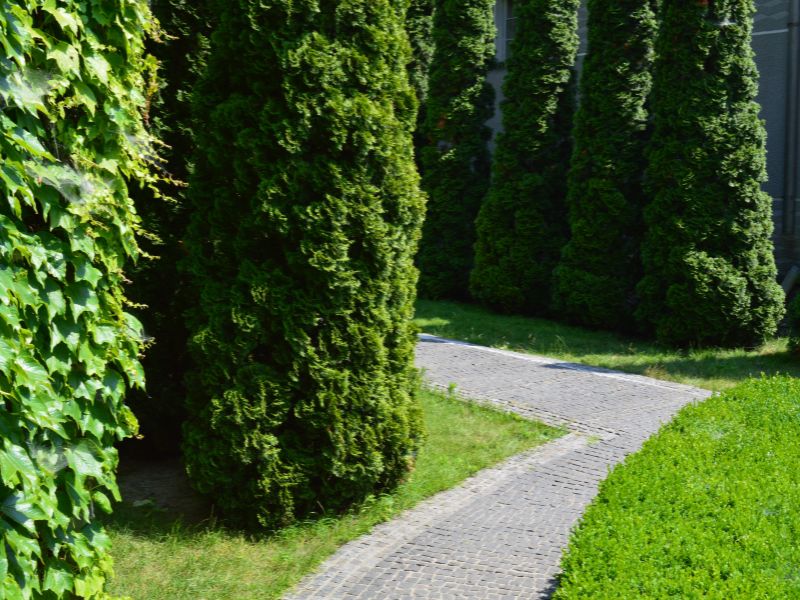
Tall, skinny trees can be a striking addition to landscaping, offering vertical interest and a touch of elegance. However, their unique shape and growth patterns present specific maintenance challenges. This article explores the ins and outs of maintaining these slender trees. It provides practical advice for ensuring their health and beauty.
Why consider tall, skinny trees for your landscape?
Tall, skinny trees can transform your garden in several ways:
- Space efficiency: Their narrow form makes them ideal for tight spaces where traditional trees might be too broad. With its slender, columnar form, the Italian cypress is a perfect example of a tree that can fit into small areas.
- Vertical interest: Lombardy poplar trees, with their tall, slender trunks and upward-reaching branches, can dramatically change the appearance of a garden by adding a vertical element to your landscape. They also help create depth and focus in garden design.
- Privacy screens: Their height can be a natural privacy screen without taking up much horizontal space. Skyrocket juniper trees are excellent for creating privacy barriers in a confined space, as their dense foliage and tall stature provide natural screening.
- Aesthetic appeal: These trees offer a modern, sleek look that complements various garden styles. Columnar maple trees, with their distinctive, upright growth habit and vibrant fall foliage, can add a touch of sophistication and colour to any landscape.
Incorporating tall, skinny trees into your landscape can enhance your garden’s visual appeal and functionality, making them a worthwhile consideration.
What are the critical maintenance tasks for tall, skinny trees?
Maintaining tall, skinny trees involves several vital tasks to keep them healthy and thriving:
- Pruning: Regular pruning helps maintain the tree’s shape and encourages healthy growth. Focus on removing any dead or damaged branches.
- Watering: Tall, skinny trees require consistent watering, especially during dry periods. Ensure the soil stays moist but not soggy.
- Fertilising: In spring, apply a balanced fertiliser to promote vigorous growth and vibrant foliage. Follow the manufacturer’s instructions for the right amount and frequency.
- Support: If your tree is young or newly planted, provide support with stakes to help it grow straight and strong.
Proper maintenance ensures that your tall, skinny trees continue to add beauty and functionality to your landscape.
How can you protect tall, skinny trees from pests and diseases?
Protecting your trees from pests and diseases is crucial for their long-term health:
- Regular inspections: Check your trees frequently for signs of pests like aphids, spider mites, or scale insects. Early detection helps prevent significant infestations.
- Proper hygiene: Remove fallen leaves and debris around the tree’s base to reduce the risk of fungal infections and pests.
- Disease management: Powdery mildew and root rot commonly affect tall, skinny trees. If you notice symptoms, use appropriate fungicides or seek professional advice.
- Healthy practices: Ensure good air circulation around the tree by avoiding overcrowding and providing ample space for growth.

You can protect your trees from common threats and ensure their continued health by staying vigilant and proactive.
What are the best mulching and soil practices for tall, skinny trees?
Mulching and soil care play a significant role in the health of tall, skinny trees:
- Mulching: To help your tree retain moisture, control soil temperature, and prevent weeds, spread a layer of organic mulch, such as wood chips or bark, around its base.
- Soil quality: Conduct a soil test to determine nutrient levels and pH. Amend the soil with compost or other organic matter to improve fertility and drainage.
- Soil drainage: Ensure that the soil drains well to prevent waterlogging, which can lead to root rot. If needed, consider adding sand or organic material to enhance drainage.
Good mulching and soil practices help provide a stable environment for your trees, promoting healthy growth and resilience.
When is the best time to plant and maintain tall, skinny trees in Sydney?
In Sydney’s subtropical climate, timing your planting and maintenance activities is essential:
- Planting: The best time to plant tall, skinny trees in Sydney is during spring (September – November) or autumn (March-May). These seasons offer mild temperatures and adequate rainfall, helping the trees establish well.
- Summer care: In summer (December – February), ensure regular watering as temperatures can be high and dry. Avoid planting during the hottest months to reduce stress on the tree.
- Winter maintenance: During winter (June – August), focus on pruning and general maintenance. Water only when necessary, as the tree’s growth slows down.

Adapting your landscaping care routine to the seasons helps ensure the best results for your tall, skinny trees. Consider consulting with a local tree service for personalised advice.
What are the benefits of hiring a professional for tree maintenance?
Hiring a professional can offer several advantages for maintaining tall, skinny trees:
- Expertise: Professionals have the knowledge and experience to handle specific tree care needs, from pruning to pest management.
- Equipment: Access to specialised equipment ensures tasks like tree lopping or stump grinding are performed safely and efficiently.
- Time-saving: Professional services save you time and effort, allowing you to enjoy your landscape without the hassle of DIY maintenance.
- Safety: Tall, skinny trees can be challenging to manage due to their height. Professionals ensure that maintenance tasks are performed safely and correctly.
For comprehensive care, consider investing in professional tree services, including tree stump grind services, to keep your landscape in top condition.
Conclusion
Maintaining tall, skinny trees for landscaping can be a rewarding endeavour. They add both beauty and functionality to your garden. Understanding the specific care requirements, such as proper pruning, pest control, and seasonal maintenance, can ensure these elegant trees thrive and enhance your outdoor space.
Enhance your landscape with professional tree care!
Maintaining tall, skinny trees can be straightforward with the right approach and knowledge. Suppose you need expert garden design and landscaping or tree care assistance. In that case, All Green Gardening & Landscaping is here to help. Our experienced team can provide tailored solutions to ensure your garden thrives throughout the year. Contact All Green Gardening & Landscaping today to discuss your landscaping needs and discover how our comprehensive services can enhance your outdoor space.
